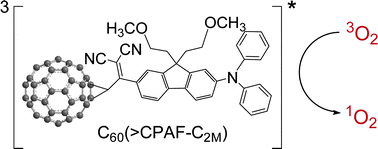Synthesis and characterization of highly photoresponsive fullerenyl dyads with a close chromophore antenna–C60 contact and effective photodynamic potential†
Abstract
We report the synthesis of a new class of photoresponsive C60–DCE–

* Corresponding authors
a
Department of Chemistry, University of Massachusetts Lowell, Lowell, MA, USA
E-mail:
Long_Chiang@uml.edu
Fax: (+978)-934-3013
Tel: (+978)-934-3663
b
AFRL/RX, Air Force Research Laboratory, Wright-Patterson Air Force Base, Dayton, OH, USA
E-mail:
Loon-Seng.Tan@wpafb.af.mil
Fax: (+937)-255-9157
Tel: (+937)-255-9153
c
Department of Pathology and Laboratory Medicine, Mount Sinai Hospital and University of Toronto, Toronto, Canada
E-mail:
kpritzker@yorkmp.com
Fax: (+416)-486-9460
Tel: (+647)-221-6909
d
Wellman Center for Photomedicine, Massachusetts General Hospital, Boston, MA, USA
E-mail:
hamblin@helix.mgh.harvard.edu
Fax: (+617)-726-8566
Tel: (+617)-726-6182
e
Department of Dermatology, Harvard Medical School, Boston, MA, USA
E-mail:
wilson@uhnres.utoronto.ca
Fax: (+416)-946-6529
Tel: (+416)-946-2952
f Aesthetic and Plastic Center of Guangxi Medical University, Nanning, P.R. China
g Harvard–MIT Division of Health Sciences and Technology, Cambridge, MA, USA
We report the synthesis of a new class of photoresponsive C60–DCE–

 Please wait while we load your content...
Something went wrong. Try again?
Please wait while we load your content...
Something went wrong. Try again?
L. Y. Chiang, P. A. Padmawar, J. E. Rogers-Haley, G. So, T. Canteenwala, S. Thota, L. Tan, K. Pritzker, Y. Huang, S. K. Sharma, D. B. Kurup, M. R. Hamblin, B. Wilson and A. Urbas, J. Mater. Chem., 2010, 20, 5280 DOI: 10.1039/C0JM00037J
To request permission to reproduce material from this article, please go to the Copyright Clearance Center request page.
If you are an author contributing to an RSC publication, you do not need to request permission provided correct acknowledgement is given.
If you are the author of this article, you do not need to request permission to reproduce figures and diagrams provided correct acknowledgement is given. If you want to reproduce the whole article in a third-party publication (excluding your thesis/dissertation for which permission is not required) please go to the Copyright Clearance Center request page.
Read more about how to correctly acknowledge RSC content.
 Fetching data from CrossRef.
Fetching data from CrossRef.
This may take some time to load.
Loading related content
